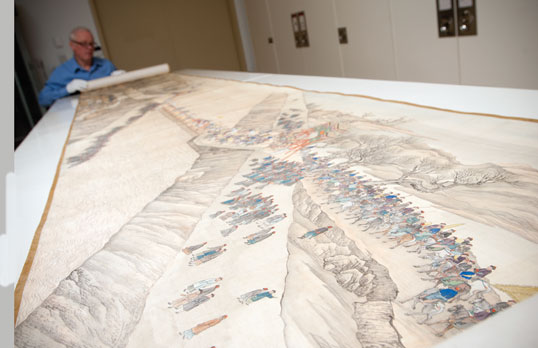
A peek inside The Mactaggart Art Collection
For 20 years, Edmonton philanthropists Sandy and Cécile Mactaggart dreamt of finding a home for their world-class collection of Chinese art and textiles. They imagined building a world-class museum right here in Edmonton, where the collection could be studied by experts and appreciated by the public. "For years I talked and talked and talked to everyone," Cécile Mactaggart said in the book Emblems of Empire. "I would get very close, then something would come up and the dream would disappear like a puff of smoke."
Then, in 2005, an unexpected solution presented itself. The Mactaggarts donated a portion of their collection - valued at $37 million - to the University of Alberta, where an award-winning, one-of-a-kind exhibition, research and storage facility was created for it.
Lovingly assembled by the Mactaggarts over the course of 50 years, the gift contains over 700 paintings and textiles, mainly from the Ming (1368-1644) and Qing (1644-1911) dynasties, and ranks among the top collections of Chinese art and textiles in the world.
Among the gems of the Mactaggart Art Collection are several elaborate silk-embroidered robes belonging to the Qing dynasty emperors and some very fine handscrolls painted by the Chinese equivalents to Michelangelo or Rembrandt in the West, such as the handscroll by Wen Zhengming on the following pages.
More online: Can't visit in person? Visit the Mactaggart Art Collection online where you can search the collection or browse the interactive online exhibit, "Brilliant Strokes," which examines dozens of prints and paintings from the collection.
In many ways, the collection itself is like that beautiful old handscroll, which must be rolled out, scene by scene, to understand the complete narrative. It is only by looking at what appears to be a disparate group of objects - a rank badge, a court robe, a painting - that one can understand the cultural, social and political realities of such a complex era.
Interested in seeing behind the scenes of the Mactaggart Art Collection yourself? The collections are accessible by appointment by contacting museums@ualberta.ca or calling 780-492-5834. The Mactaggart Art Collection is housed in the University's TELUS Centre at the corner of 87th Ave. and 111th St. For more information, visit: http://museums.ualberta.ca/mactaggart/.
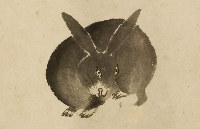
Dragon and Phoenix roundel (detail): Rank badges such as this one were worn by all members of the imperial court, with different animals representing different ranks: birds for civilians, mammals for military, dragons for the imperial family. This silk rank badge was made for the empress and also features her personal emblem - the phoenix - creating a balance of yin and yang that was central to Chinese belief: the dragon and the phoenix, the male and female, the emperor and the empress.
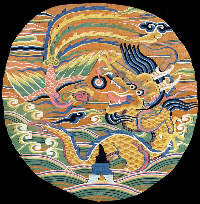
Leaf from Album of Flowers and Birds (detail): The artist behind this painting of a rabbit, Luo Ping, was a versatile painter of landscapes, flowers, animals, figures - even ghosts. A virtuoso with brush and ink, he executed this painting in the surprisingly difficult, "boneless style" - without an outline - and includes the inscription "painted from life." Indeed, this simple portrayal seems to capture the rabbit's very essence.
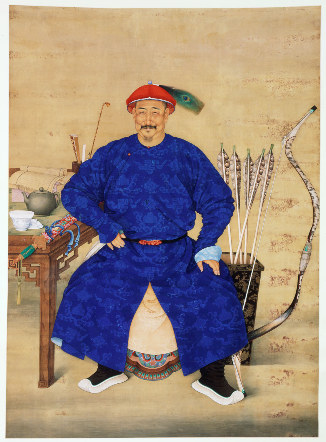
Portrait of a Manchu Bannerman: Everything about this portrait says something important about the unknown sitter. His style of clothing - especially his hat - cast him as a fourth-ranked Manchu, the nomads who conquered China in the 17th century establishing the Qing dynasty. His brocade-covered sword and his bow and arrows are a testament to his military prowess, while his other accessories - the brush, the books, the teapot - reveal his refined tastes as a Confusian wenren, or man of letters.
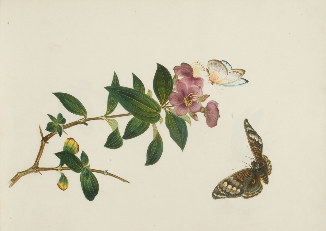
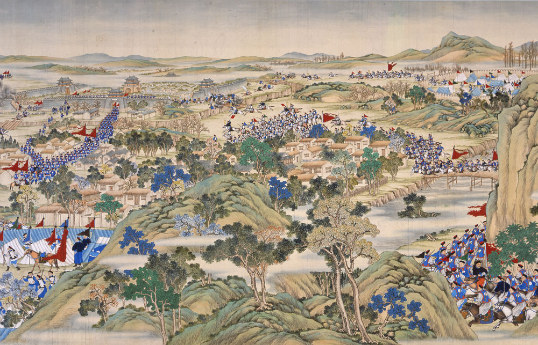
Battle scene from the Muslim Rebellions in Shaanxi, Gansu, and Xinjiang Provinces (detail): This is one of 67 paintings commissioned by the Guangxu emperor in 1885 to show his success at squashing rebellion. Such paintings were intended to glorify the emperor, depicting the superior numbers and discipline of his military, and were housed in his Throne Hall, where he received foreign ambassadors.
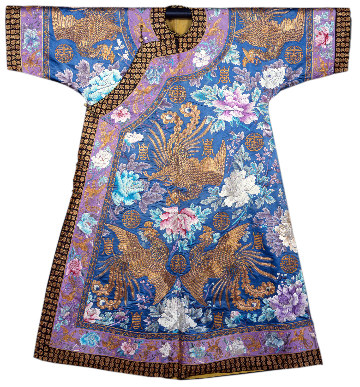
Informal court robe for the Empress Dowager Cixi: The imperial family distinguished itself from other members of court by the colour, the quality of the embroidery and the nature of the sym-bolism of their robes. A close look at this robe, belonging to the Empress Dowager Cixi (1835-1908), reveals the subtlest shading of colours and the perfect execution of each tiny stitch. Likewise, the design features nine golden phoenixes - a number signifying heavenly perfection - flanked by variations on the character for "long life," symbolism that would have been reserved for the empress dowager.
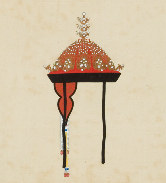
Illustration of Costumes from the Qianlong Court(detail): In 1784, the Qianlong Emperor appointed a commission to overhaul the rules for court dress. The new rules were laid out - in excruciating detail - in illustrated albums that explained exactly what each member of court was to wear, how they were to wear it, and when. This illustration depicts a formal court hat, bedecked with pearls, that was to be worn by the empress dowager in the winter. Originally, there would have been about 6,000 of these illustrations. Only 600 are known to exist today - mostly in British Museums - and 34 of those are part of the Mactaggart Art Collection.
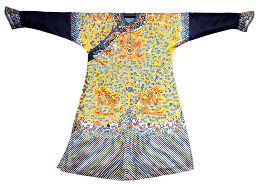
Embroidered Yellow Silk Imperial Twelve Symbol Robe: Rules governing dress were an important means for maintaining order by clearly designating rank and status. There were five official robe colours: black, blue, red, yellow and white, and each dynasty adopted a new colour upon its ascension to the throne. The Qing dynasty (1644-1911) selected this particular bright shade of yellow for the robes of its emperor, empress dowager and empress. There are many such bright yellow robes in the Mactaggart Art Collection, including this one, which belonged to the Guangxu emperor and dates from the late 1880s.
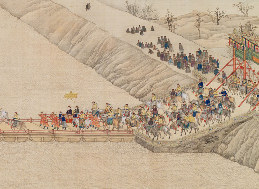
The Qianlong Emperor's Southern Inspection Tour (detail): Following in the footsteps of his grandfather, the Qianlong emperor embarked on six inspection tours of his lands in southern China, and, like his grandfather, he ordered the court painters to commemorate his tour with 12 monumental paintings. This hand-painted scroll depicts the second leg of the journey, near the city of Dezhou, and measures a staggering 17 metres long. This detail shows the emperor riding a palanquin with part of his large entourage.
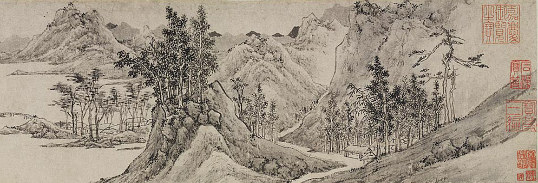
River Landscape by Wen Zhengming (detail): Although small at only 17 cm tall, this handscroll painted by Wen Zhengming is one of the most valuable artifacts in the collection. Considered a master artist in China - equivalent to Michelangelo or Rembrandt in the West - Zhengming was also lauded in his own day, as evidenced by the many positive commentaries about him inscribed by other notable artists at the left side of the scroll.
Emblems of Empire: Selections from the Mactaggart Art Collection: When the Mactaggarts began collecting, they were convinced that the objects that excited and inspired them would excite and inspire others. In fact, their collection has already inspired three books, including, most recently, the 368-page, full-colour Emblems of Empire, written by two of the world's leading experts in Qing dynasty art and costume. All three books are available from the University of Alberta Press (www.uap.ualberta.ca).
We at New Trail welcome your comments. Robust debate and criticism are encouraged, provided it is respectful. We reserve the right to reject comments, images or links that attack ethnicity, nationality, religion, gender or sexual orientation; that include offensive language, threats, spam; are fraudulent or defamatory; infringe on copyright or trademarks; and that just generally aren’t very nice. Discussion is monitored and violation of these guidelines will result in comments being disabled.